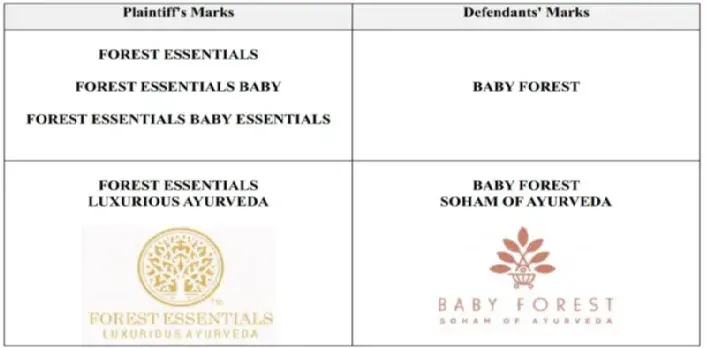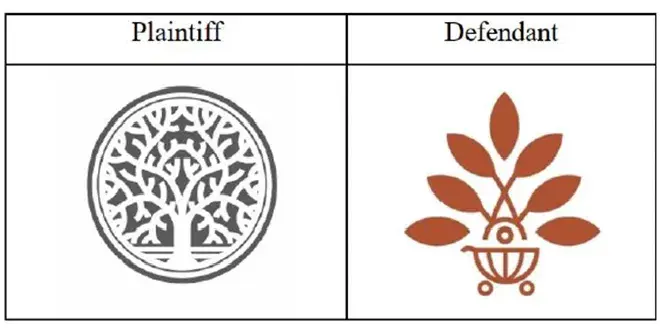By Rima Majumdar and Aishwarya Hariharan
*The order is currently challenged in Appeal before the Division Bench, Delhi High Court in FAO(OS) (COMM) 111/2024*
A dispute concerning the defense of prominent part of a trademark and registration of part of a trademark was recently decided by the Hon’ble Delhi High Court whilst refusing to grant a temporary injunction to the Plaintiff in the case of Mountain Valley Springs India Private Limited vs. Baby Forest Ayurveda Private Limited[1]. The suit was between two companies operating in identical business of ayurvedic and skincare products: the Plaintiff under the mark FOREST ESSENTIALS and the Defendant under BABY FOREST and Baby Forest- Soham of Ayurveda.
By denying the interim relief sought by the Plaintiff Forest Essentials, the Court has provided critical insights into three key factors—monopolies, sophisticated consumer testing, and global appreciation — to assess contemporary trademark confusion on generic terms and trademark protection.
Background of the Case
The Plaintiff, Forest Essentials a well-established brand in the ayurvedic skincare market, had filed a suit seeking permanent injunction against the Defendants from infringing upon their trademarks Forest Essentials’, ‘Baby Essentials’, ‘Forest Essentials-Baby Essentials’, ‘Luxurious Ayurveda’, and ‘Soundarya’ by using the impugned marks “BABY FOREST’ and ‘BABY FOREST–SOHAM OF AYURVEDA”.
A visual representation of the competing marks is as under:

- Plaintiff’s Arguments:
- Prior user and goodwill:
The Plaintiff has been in the ayurvedic skincare industry since the year 2000 and enjoys immense goodwill and reputation for its mark FOREST ESSENTIALS, be it through its sales turnover, presence pan India and outside, advertising expenditure, presence in multiple hotels, and others.The Defendants changed their trade name to ‘Baby Forest Ayurveda Private Limited’ in 2023, and earliest invoice with this name mentioned is of July 2023. Also, this invoice does not mention the mark BABY FOREST anywhere. These changes show that the Defendant tried to come as close as possible to the Plaintiff, to ride on their goodwill. - Trademark Registrations:
The Plaintiff has trademark registrations for both word and logo marks for FOREST ESSENTIALS in multiple classes, such as class 3, 5, 9 10, 16, 20, 21, 25, 29, 30, 31, 32, 33, 35,41 and 42. The same provides them with statutory, exclusive rights. - Prior in market for baby products:
The Plaintiff has continuously sold its Mother and Baby care products since 2006 under its marks ‘FOREST ESSENTIALS BABY ESSENTIALS’ and ‘FOREST ESSENTIALS BABY’. For its baby care range of products, the Plaintiff claims significant annual sales of approximately Rs. 15 crores as well. - Consumer Confusion:
The Plaintiff claimed that the similarities between the two marks are causing customers to think Baby Forest is related to the Plaintiff’s brand. Against this averment, certain emails, social media comments, and Google search results were shown by the Plaintiff. - Contradictory pleas by Defendant:
The Defendants in one of their oppositions against the Plaintiff application for the mark FOREST ESSENTIALS BABY, had taken the stand that the Plaintiff’s mark was deceptive and detrimental to the Defendant’s. Therefore, the Defendants had in a way admitted that there is confusion between the two marks. - Dishonest intent behind adoption of this mark:
In addition to adopting the tradename and similar trademarks, a similar ‘Tree’ logo, proves Defendants malicious intent in coming as close as possible to the Plaintiff, to ride on its goodwill and reputation. - Initial interest confusion:
The trade channels of both products are similar, Defendant has a store in same mall where the Plaintiff has a store, products are identical and have a common class of consumers, hence there is initial interest confusion.
- Prior user and goodwill:
- Defendant’s arguments:
- Trademark Registrations for Forest Essentials Baby was an afterthought:
Only after the Court refused to grant an ex-parte interim injunction to the Plaintiff, they filed multiple applications for registration of the mark “Forest Essentials Baby” and “Forest Essentials- Baby Essentials”. The same demonstrates that these marks were not considered as trademarks earlier.The Defendants were granted registration of the mark ‘BABY FOREST’ on January 28, 2021 in Class 3 under No. 4549589 w.e.f. June 30, 2020, without any opposition from the Plaintiff. Subsequently, the registration of the domain name ‘babyforest.in’ was done in July 2020 and the Defendants launched their products in August 2022. Much later, on June 16, 2023, the Plaintiff sent a legal notice to the Defendants, which had no mention of the marks ‘Forest Essentials Baby’ or ‘Forest Essentials- Baby Essentials’. - Generic Nature of the word “Forest”:
The Defendants contend that the term “Forest” is a dictionary word, and it cannot be monopolized by any single entity. Further, the word “Forest” in itself is descriptive and widely used in various contexts, making it ineligible for exclusive trademark protection. In fact, there are over 100 registrations in class 3, containing the mark FOREST in it, showing that it is commonly used in cosmetic and skin care products. - Distinctive Products and Branding:
Defendants emphasized that their product line focused solely on baby care, was distinctly different from the broader range of products offered by the Plaintiff under the mark “Forest Essential”. It was also contended that the range of products offered by the Defendants was also wider than what the Plaintiff offered under its baby care range. Defendants further claims that the packaging, trade dress, branding, target market and even the adoption of the impugned ‘Tree’ logo for their products were sufficiently different than that of the Plaintiffs’, thus establishing the lack of confusion between the consumers of both parties. The difference between the Plaintiff and Defendants’ tree logo is as under:
- Registration of Plaintiff’s Marks:
Defendant contends that the Plaintiff has always used ‘Forest’ and ‘Essentials’ together, and does not have a separate registration for the word ‘Forest’ under Section 17(2) of the Trade Marks Act, 1999.
- Trademark Registrations for Forest Essentials Baby was an afterthought:
Judgement
The Hon’ble High Court of Delhi, while dismissing the application seeking interim injunction restraining the Defendants from using the mark “Baby Forest” or any other mark identical or deceptively similar to the Plaintiff’s mark “Forest Essentials”, made the following observations vide judgment dated May 21, 2024:
- The Plaintiff never sought registration of the marks FOREST ESSENTIAL BABY and FOREST ESSENTIALS-BABY ESSENTIALS, even though they have claimed use of these marks from 2006. The fact that after ex-parte interim injunction was refused, the Plaintiff applied for these registrations, shows that the Plaintiff was not trading under the said marks and the word ‘Baby’ and ‘Baby Essentials’ was merely used as a descriptive term along with their main house mark ‘FOREST ESSENTIALS’. The said house mark is also the main mark on which the Plaintiff’s goodwill and reputation hinges.
- Plaintiff cannot claim dominance over a generic term: The Court ruled that the word “Forest” is generic and cannot be claimed exclusively by the Plaintiff without specific registration of part of the mark FOREST under Section 17(2) of the Trademark Act, 1999.The Court referred to the decision of Vardhman Buildtech Pvt. Ltd. v. Vardhman Properties Ltd. 2016 SCC OnLine Del 4738, wherein it was held that registration does not confer exclusive rights in part of the mark.Besides, the existence of other FOREST formative trademarks, some which exist even prior to the user of the Plaintiff shows that Plaintiff cannot claim monopoly over it.
- Anti-dissection rule: The Court noted that in its reply to the Examination Report for the mark FOREST ESSENTIALS the Plaintiff had taken a basic stand that, uniqueness of their mark is in using the word “Forest” and “Essentials” together. Therefore, when this unique combination is the one that has achieved the reputation, the rule of anti-dissection will prevail, which prevents exclusive rights over a part of the mark. The court noted that while the combination may be distinctive, the individual components (“Forest” and “Essentials”) are not inherently protectable in isolation.
- Average intelligence and imperfect recollection test: The Court cited the test of a ‘customer of average intelligence and imperfect recollection’ (originally articulated in Corn Products Refining Co. v. Shangrila Food Products Ltd., 1959 SCC OnLine SC 11, by the Hon’ble Supreme Court). When considering brand choice, it is essential to consider the category of goods, their price range, and the accessibility of relevant information through the internet and social media platforms, which can help clarify and influence brand preferences.The Court held that with the advent of time and rapid increase in technology and resources, it is not uncommon for a customer of average intelligence and imperfect recollection to cross check the origin of a product and the particulars of a brand by taking advantage of the substantial data and resources available to the consumer through the access of the internet. When it comes to baby care products, purchasers, typically parents, exercise extra caution in selecting the right product or brand for their babies.
- Evidence of consumer confusion: The evidence presented by the Plaintiff was deemed insufficient to establish significant consumer confusion. The Court held that the instances of alleged confusion, such as social media posts and customer inquiries, did not demonstrate widespread or likelihood of confusion among the relevant consumer base. The court observed that minor confusion among customers does not warrant a complete injunction against the Defendant’s mark.
- Pianotist Test – The Court cited the “Pianotist test” established by Parker J. in Pianotist Co. Application, (1906) 23 RPC 774, as a fundamental framework for assessing infringement, deception, confusion, association. It is underscored that the test itself adumbrated by Parker J includes assessing customer behavior and surrounding circumstances. The ‘Pianotist test’ includes “you must consider the nature and kind of customer who would be likely to buy those goods” and “in fact you must consider all these surrounding circumstances….” This test emphasizes the importance of considering customer behavior and surrounding circumstances, including the nature and type of customers likely to purchase the goods, and considering all relevant factors.
- The Court ruled that the Plaintiff’s claim of ownership over the trademarks “Forest Essentials Baby” and “Forest Essentials Baby Essentials” was not convincing, at least at the prima facie stage.
- Goodwill and Reputation: The Court admitted that Plaintiff’s documents primarily demonstrated their reputation and goodwill associated with their main brand name “Forest Essentials” range aimed at adults, with minimal references to baby care products. Plaintiff’s registrations were confined solely to the house mark “Forest Essentials.” Furthermore, just because the Plaintiff had higher annual turnover, it did not justify displacing a registered mark BABY FOREST when they themselves do not have any registration for FOREST ESSENTIAL BABY.
Based on these findings, the Learned Single Judge denied the interim injunction sought by the Plaintiff.
Conclusion and Author’s note
While Forest Essentials has challenged this order and the Learned Division Bench has so far given a prima facie view that the learned Singh Judge was wrong in interpreting the doctrine of initial interest confusion, this interim order comes as a critical precedent for brand owners standing at the Defendant’s podium and facing allegations of infringement/passing off.
The order thinks of a revised form of ‘consumer with average intelligence and imperfect recollection’, by placing this customer in the age of the internet. By doing so, the learned Single Judge has in a way, changed the ‘average consumer’ to an “informed/aware consumer” and turned the trajectory of adjudicating trademark matters.
While the Court has acknowledged that a brand encompasses multiple elements, including the word mark, device mark, trade dress, get-up, layouts, artistic work, online and social media presence, positioning, price point, and target consumer, the same effects the likelihood of confusion, disruption, and likelihood of association. The Court should therefore assess these scenarios in a comprehensive context rather than in isolation.
However, the Single Judge’s ruling also underscores the necessity for brands to carefully consider their trademark strategies and to ensure robust legal protection for their marks. Few things to consider in this regard would be:
- Conducting trade mark search prior to applying for a mark to find out if you are in conflict with an existing mark. For this, it is important that the branding/marketing team and in sync with the legal team.
- Being mindful of what one is submitting in their reply to examination reports before the Trade Mark Registry. Often, to expedite the examination process of a trademark application, brands may submit that the mark is to be seen as a whole or give disclaimers to part of the mark. The same then binds you in future and may even hinder you from taking legal action of infringement/passing off.
- Keeping a watch of marks that are advertised in the Trade Mark Journal, so that conflicting marks can be opposed within the statutory period of 4 months, instead of letting them pass to registration.
- File registrations for part of their mark, in addition to the entire mark, if part of a trademark is capable of being registered separately.
Anuj Dhar, Assessment Intern at S.S. Rana & Co. has assisted in the research of this article.
[1] CS(COMM) 523/2023


